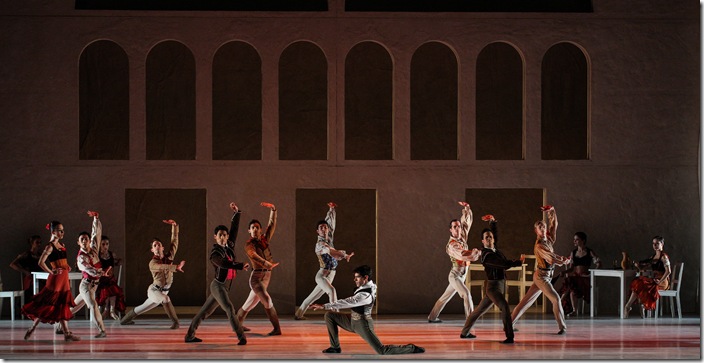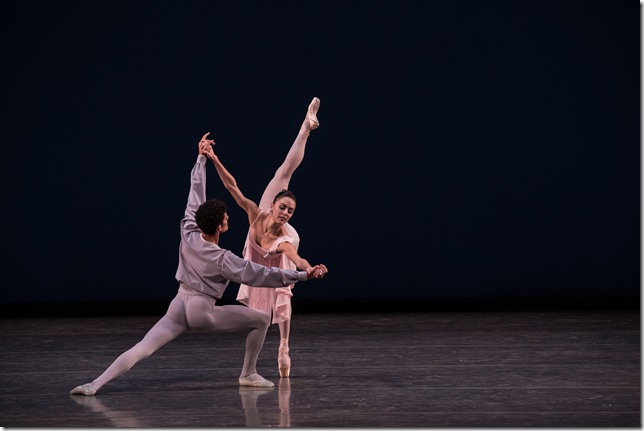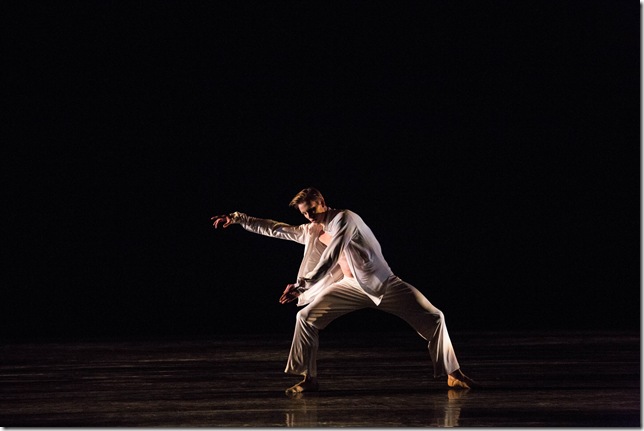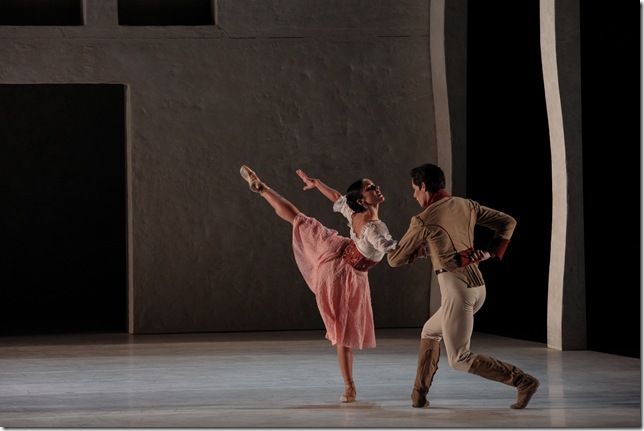By Tara Mitton Catao
Artistic Director Lourdes Lopez’s vision for Miami City Ballet was apparent in the tasteful programming of Saturday’s performance at the Kravis Center, with the de rigueur Balanchine work leading off the evening followed by two company premieres.
Lopez who has been “shopping” for new works that would flatter and challenge the company, has been successful. For Program III: Passion and Grace, she brought a rarely seen contemporary work by avant-garde choreographer Tywla Tharp and a sleek contemporary take on the tale of Carmen by British choreographer Richard Alston. Like Balanchine, both of these dance-makers are known for their extremely musical choreography.
The program, ruled by the Delgado sisters, Patricia and Jeanette, with a welcomed sprinkling of new faces doing lead roles, was appealing, well-balanced and well-danced. The company looked strong and confident. The Opus One Orchestra played with gusto and aplomb and the production values were polished and refined.
For the Balanchine selection, Lopez selected Allegro Brillante, set to the exceedingly danceable music of Peter Ilyich Tchaikovsky, his one-movement Third Piano Concerto. Company pianist Francisco Rennó set an invigorating tempo and tone, to which the dancers responded with ease and a real sense of pleasure.
Balanchine is said to have commented that Allegro Brillante “contains everything I know about classical ballet — in 13 minutes.” Interesting to note, it was also quickly choreographed by Balanchine in order to replace at the last moment another work in a program, which is possibly why, Balanchine threw in everything but the kitchen sink in this myriad of ballet steps. The lead female was created for his then-wife, the famous ballerina Maria Tallchief.
On Saturday night, the demanding role was danced with the necessary speed and precision by the always delightful Patricia Delgado who stepped in with her cavalier, Renan Cerdeiro, to replace the cast listed in the program. Choreographed in 1956, the work, which includes four other couples, was lighthearted, fast-paced and a perfect dose of pure Balanchine-style ballet. The male dancers were particularly strong, dancing with wonderful clarity and elegance in their lines and technique.
Twyla Tharp has said that she admires Balanchine enormously and highly respects his dances. And like Balanchine, Tharp’s works usually demand strong, precise technique and endless high energy from the performers. But Lopez selected Sweet Fields (which is a quietly understated work and accompanied by an all-choral score) to round out the MCB collection of Tharp works. The work is serenely beautiful and here in the evening’s program, it served as a nice contrast to previous flurry of movement in the light and airy, pastel-hued Allegro Brillante.
The dancers looked gorgeous in Norma Kamali’s striking and sleek off-white costumes. The women, bare-legged with flapping long coats, and the men, bare-chested with flapping, open shirts, moved in a ritualistic manner etched in Jennifer Tipton’s monochromatic but glowing lights. In her tribute to Americana, Tharp uses a cappella choral hymns from the Shaker tradition, The Sacred Harp and William Billings, the pioneering 18th-century American composer.
Leading in the cast for the first hymn, Chase Swatosh showed another side to his talent as a dancer. Tall and blond, he looked natural and elegant as he connected and fully executed the sinewy and luscious movement phrases that were the building blocks of the formal patterns that the ensemble rendered with a subdued elegance. Leigh-Ann Esty was also very lovely, standing out throughout the dance as she kept reappearing during the 10 sections.
Finishing the evening and continuing the visual feast was the company and U.S. premiere of Richard Alston’s Carmen. The curtains parted and revealed an absolutely stunning and quite unexpected set and lighting. The surprising, sparse modernistic approach to the famed operatic tale of Carmen was beautifully executed by Peter Mumford in his scenic and lighting design. The stylized arched building façade, together with a white dance floor, were almost like a blank canvas from which the colors of the lighting design could bounce off.
Complemented with the well-designed costumes of Anthony McDonald, this version of Carmen looked like it could have happened in between some scenes of Goya’s famous paintings of France invading Spain in the early 1800s, but with a bold contemporary overlay.
While everyone recognizes and responds to the emotion-filled melodies of Georges Bizet’s Carmen, Alston chose to use Russian composer Rodion Shchedrin’s Carmen Suite, an adaption of Bizet’s famous score. Arranged for strings and percussion, Shchedrin created his 55-minute version for a 1967 Bolshoi production of Carmen that feature his wife, prima ballerina assoluta Maya Plisetskaya.
This fresher rendition with cowbells and rattles in the percussion together with the striking set (beautiful in its economy) allowed us to focus on the dancing, and there is a lot of wonderful dancing. This story ballet is a great fit for MCB. The corps de ballet reveled in the musicality of the steps and the orchestra vibrated in response.
The role of Carmen alternates between the Delgado sisters, and Saturday night it was Jeanette who danced the feisty role of Carmen. With confidence and sass — and her ever-present technical finesse — she pulled Jovani Furlan, who danced the role of the young be-smitten corporal, into her grasp. Nathalia Arja and Jennifer Lauren, cast as Carmen’s friends, also danced with the same confidence, sass and technical finesse. Jennifer Carlynn Kronenberg was excellent in her depiction of the doom-predicting fortune teller.
Things moved quickly amongst all the lively dancing, the beautiful costumes and the brilliance of the set. Suddenly we were at the dramatic end and wondered how we got there. It seemed like an abridged storyline (sort of like a Monarch Notes version) but we do know the story. So perhaps the fact that there is not much building of the drama until the very end is OK, as we have been richly entertained both visually and kinetically.



